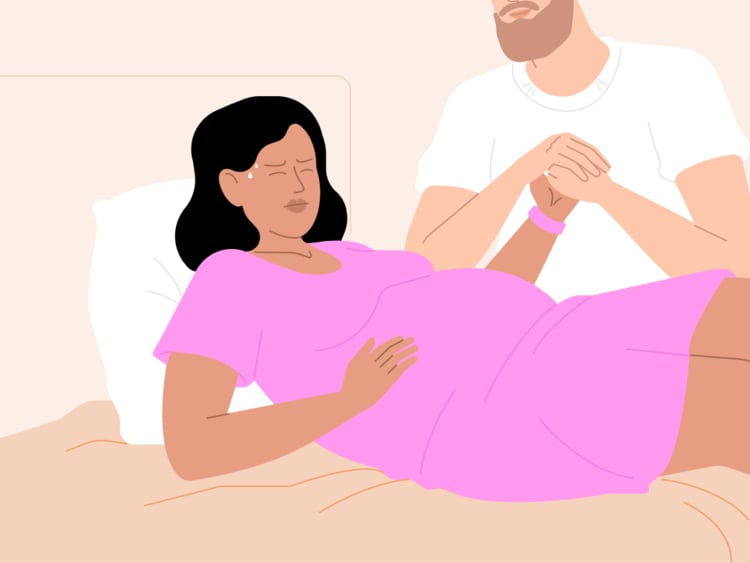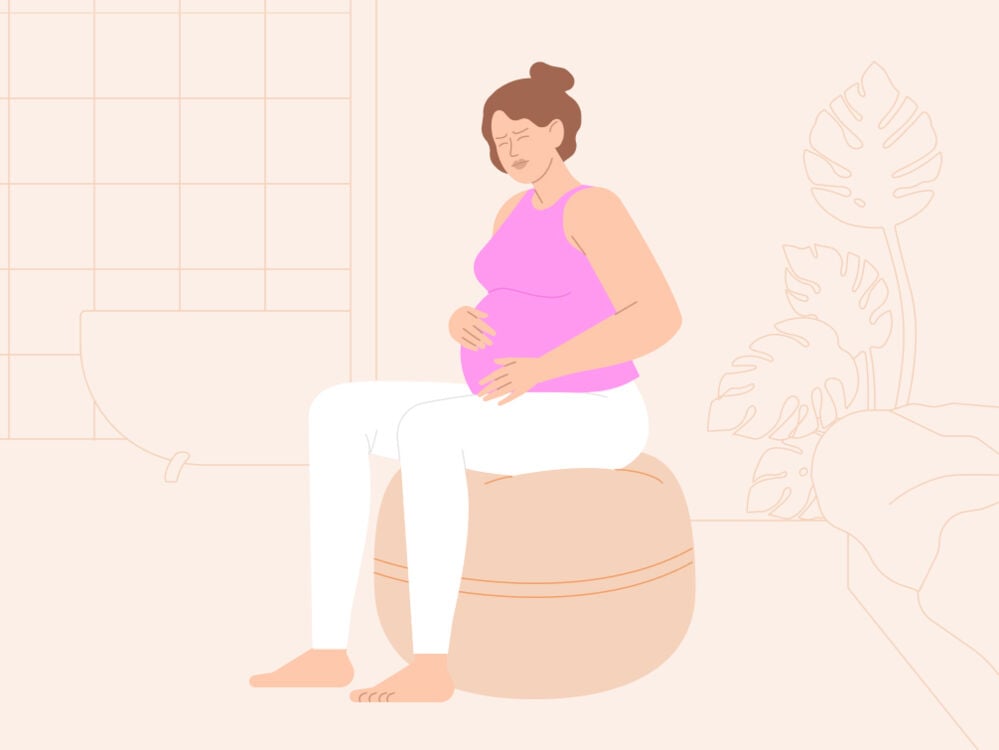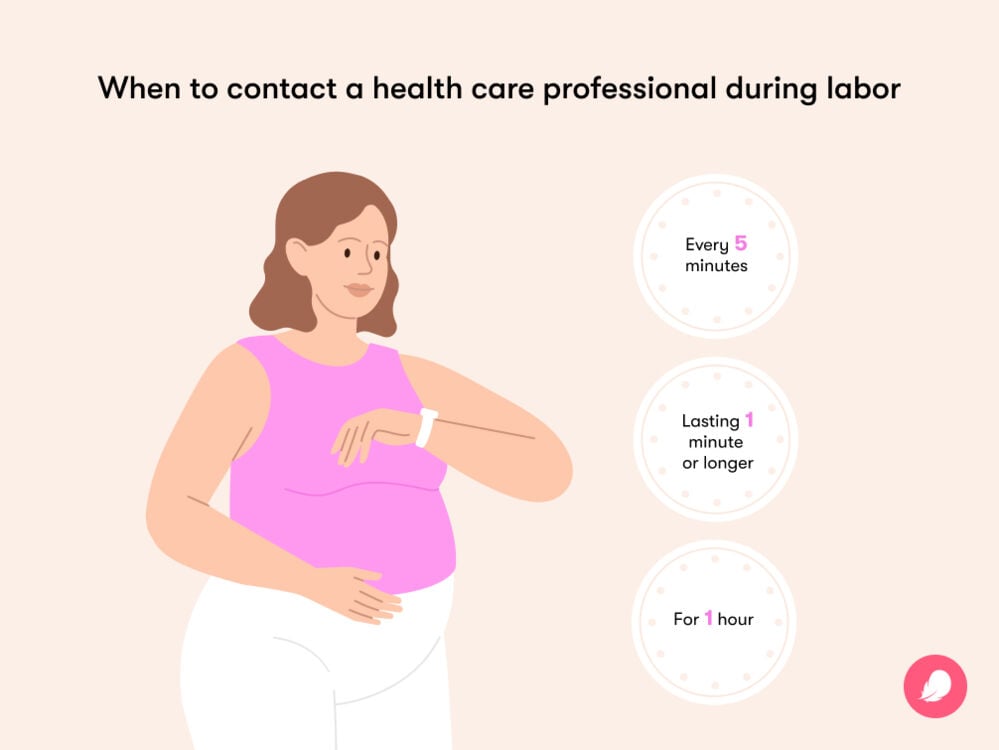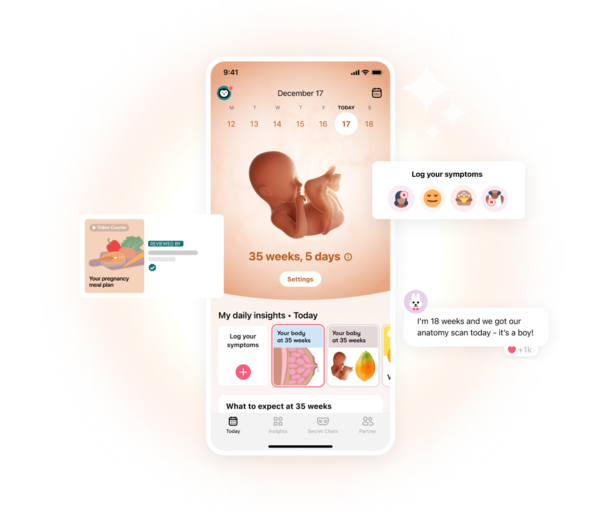It’s natural to wonder what a contraction might feel like, especially if you’re pregnant for the first time. Here, Flo members share their experiences.
-
Tracking cycle
-
Getting pregnant
-
Pregnancy
-
Help Center
-
Flo for Partners
-
Anonymous Mode
-
Flo app reviews
-
Flo Premium New
-
Secret Chats New
-
Symptom Checker New
-
Your cycle
-
Health 360°
-
Getting pregnant
-
Pregnancy
-
Being a mom
-
LGBTQ+
-
Quizzes
-
Ovulation calculator
-
hCG calculator
-
Pregnancy test calculator
-
Menstrual cycle calculator
-
Period calculator
-
Implantation calculator
-
Pregnancy weeks to months calculator
-
Pregnancy due date calculator
-
IVF and FET due date calculator
-
Due date calculator by ultrasound
-
Medical Affairs
-
Science & Research
-
Pass It On Project New
-
Privacy Portal
-
Press Center
-
Flo Accuracy
-
Careers
-
Contact Us
What does a contraction feel like? How to recognize the main sign of labor


Every piece of content at Flo Health adheres to the highest editorial standards for language, style, and medical accuracy. To learn what we do to deliver the best health and lifestyle insights to you, check out our content review principles.
If you’re nearing the end of your pregnancy, you might be on high alert for any signs that you’re going into labor. This can be equal parts exciting and nerve-racking, especially if you’re a first-time mom and you’re unsure of what to expect.
Learning as much as possible about what’s ahead of you can help you feel more prepared about giving birth. So, if you’re wondering what contractions feel like, what the different types of contractions are, and where they might be felt in your body, read on. We’ve turned to Secret Chats, the safe and friendly community space on the Flo app, to share different members’ experiences of contractions so you can feel one step ahead.
Key takeaways
- Contractions happen when the muscles in your uterus tighten and relax in preparation for giving birth.
- There are lots of different types of contractions, and not all of them mean your baby is on its way soon.
- Labor contractions can be felt in your abdomen, pelvis, or back. They usually follow a regular pattern and get closer together as time goes on.
- You can use the Flo app to track your pregnancy and keep up to date with all your baby’s developments. Flo’s expert information may also help you to feel calm and prepared for labor.
What are contractions?
First up, let’s start with the most important question: What exactly are contractions? Put simply, contractions happen when your uterine muscles tighten and relax in preparation for delivery.
But if you think you’re having a contraction, it doesn’t necessarily mean your baby will be here soon. There are lots of different types of contractions, and their type and intensity will depend on where you are in the process of pregnancy or labor.
Now for another important question: Where do you feel contractions in your body? Generally, if you’re having contractions, then you can expect to notice a tightening sensation across your abdomen and pelvis and sometimes a pain in your back.
Types of contractions
Now that we know what a contraction is and where we can expect to feel it, let’s take a look at the contractions you’ll experience throughout the different stages of labor.
- Prodromal labor: Prodromal labor is a form of false labor contraction that generally happens during your 3rd trimester. These contractions are more intense than practice contractions (known as Braxton Hicks) and can arrive every five to 10 minutes and last around 60 seconds each, like real labor contractions. However, they don’t cause your cervix to open, and they don’t become more intense or closer together over time. This can be confusing (and frustrating!), but try to think of them as a practice run for what’s to come.
- Early labor: The first stage of labor is split into two parts: early and active labor. Early labor is when your cervix dilates from 0 to 6 cm. Your contractions may still be irregular during this time, and some will be more intense than others.
- Active labor: Next up is active labor, which is when your cervix dilates from 6 to 10 cm. During active labor, your contractions will become stronger, more regular, and closer together. You’ll feel this pain in the abdomen, pelvis, and sometimes your back. You may also experience leg aches or cramps, lightheadedness, and nausea.
- Birth: The second stage of labor begins when your cervix is fully dilated and it’s time to push. This may feel like the most exciting stage of labor, but it can also be the most physically challenging. You will usually feel a strong urge to push at this time, and it may feel like you need to poop. During this stage, your health care team will help you to make your pushing as effective as possible if you want them to, suggesting when to push harder or more gently.
- Delivering the placenta: After you’ve given birth, there’s still one final stage of labor to go — you need to deliver the placenta. You will experience milder contractions that are closer together as your uterus pushes this into the birth canal, and you might need to push again to deliver it. After the delivery, you’ll continue to feel contractions, but thankfully much milder, as your uterus returns to its normal size.
- Post-birth: Some women will experience occasional contractions, known as afterpains, for a few days after delivery. These can feel similar to menstrual cramps, and while they’re uncomfortable, they’re doing an important job. They work to compress the blood vessels in the uterus and prevent excessive bleeding. However, if they’re painful, speak to a health care professional — they may recommend you take an over-the-counter painkiller to help.

Braxton Hicks contractions vs. real contractions
You might have heard of practice or nonlabor contractions, sometimes called Braxton Hicks contractions. These are not labor and won’t lead to giving birth, but they’re a normal part of pregnancy and can happen from the 2nd trimester onward.
There are a number of differences between Braxton Hicks and real labor contractions that you can watch for if you’re trying to figure out whether or not you’re going into labor:
- Differences in how often they come and how long they last: Labor contractions will follow a regular pattern, getting closer and closer together as your body begins to give birth. They’ll also last around 60 to 90 seconds each. In comparison, Braxton Hicks contractions are irregular, and the length of each can change.
- Differences in where they happen: Labor contractions can move from the back of your body to the front, while you’ll typically only feel Braxton Hicks in the front of your belly.
- Differences in strength: Usually, labor contractions are stronger and more intense than Braxton Hicks contractions.
- Differences in movement: Braxton Hicks contractions can generally be eased by moving around, resting, or changing position, but you won’t be able to stop labor contractions.
Remember, if you think you’re going into labor, always speak to your doctor or midwife. It might end up being a false alarm, but it’s always good to be sure.
What do contractions feel like? Flo members share their stories
The fact that we’re all different — and every pregnancy and birth is different — means nobody can tell you for certain what contractions feel like. But it can be really useful (and even reassuring) to hear from others about their experiences of labor pain. Here are some of the perspectives Flo members shared in Secret Chats.
- “So, you know that pain you feel when your calf muscle cramps, and you go into a mini shock state? OK, imagine that happening to your uterus over and over. It feels like it cramped up and went all stiff. I know every woman’s birth is different, but IT WAS NOT like bad period pain. I feel like it doesn’t even compare.”
- “Early labor was truly like period cramps, though with a greater regularity and intensity.”
- “Active labor, for me, was definitely not like period cramps — it was more like a distinct feeling of being stretched inside like a hand is kneading you like dough. To be honest, it is painful but manageable (I felt I could ‘breathe through it’). The contractions felt like being crushed between two waves. I, for the life of me, cannot remember how they felt in my body. It was truly awesome.”
- “For any expecting mama out there worried about labor: I have a very, very low pain tolerance, and I made it through a natural birth. The contractions were very, very intense and very, very painful, but I made it through, and now I have a beautiful baby girl. If I can do it, anyone can do it!!”
- “I didn’t even know I was having contractions, just some intermittent pain which I’d had most of my pregnancy. I pushed three times, and the baby came out. I was in labor for less than 30 minutes, and this was my first pregnancy.”
So, as we can see, there are many different experiences when it comes to describing what a contraction feels like. Like with all things, it’s best not to compare yourself to others or to worry too much in advance. You will be in safe hands, and your body is doing what it needs to do to get your baby out.
Can you have contractions but not feel them?
It’s true: As your body gets ready for labor, you might not feel any contractions at all. But that doesn’t mean they’re not going on in the background in preparation. When active labor starts, however, chances are you’ll know.
One sign that your body is getting ready is seeing your mucus plug. This builds up at the start of the pregnancy to block your cervix, protecting the baby from infection. As your cervix starts to soften and open in the days or sometimes weeks before labor, your cervical mucus may come out. This can be off-white in color and stringy or jelly-like in texture. Other telltale signs that your baby is coming are a bloody show (a pink or slightly bloody discharge) or your water breaking.
Take a quiz
Find out what you can do with our Health Assistant
Other symptoms that may be feel like a contraction
There are some common pregnancy symptoms that can be easily confused with contractions. The main ones are:
- Round ligament pain: As the uterus and surrounding ligaments stretch during pregnancy, it can cause aches, cramps, or sharp shooting pains that travel from your abdomen to your groin. Round ligament pain is often triggered by sudden movements or coughing and sneezing.
- Back pain: Backache is very common in pregnancy. As your ligaments stretch, it can put extra strain on your lower back and pelvis.
How can you ease contractions?
Even if your contractions aren’t particularly painful, they may well be uncomfortable, especially as your labor progresses. Experts recommend the following things to help ease contractions:
- Go for a gentle walk, pausing to breathe deeply through your contractions if necessary.
- Take a warm bath or shower.
- Change positions or try a birthing ball.
- If you can, try having a gentle massage between your contractions.
When to contact your doctor or midwife
Talk to your team about when you should call if you notice signs of labor. Each person and pregnancy is different, and a health care professional can give you personalized advice about when you should call. They’ll take into consideration how far you live from the hospital or birth center, any problems you have had during your pregnancy, and if you’ve given birth before.
In general, most health care teams recommend calling when you have had contractions every five minutes, each one lasting one minute, for about an hour. But remember, if you’re not sure if it’s time or not, it’s always a good idea to speak to call a medical professional. It’s OK if it turns out to be a false alarm.

If you experience any of the following signs, then be sure to speak to a doctor or go to a hospital:
- You have bleeding like a period or heavier from your vagina.
- You have severe pain that doesn’t stop between contractions.
- You think your water might have broken, but you can’t feel any contractions.
- Your baby is moving less often than it was before.
- You have a fever or feel sick.
Even though these symptoms can be frightening to experience during pregnancy, try to stay calm. Your health care team will check you over and run any necessary tests to make sure that you and your baby are both OK.
It’s natural to feel anticipation or anxiety about contractions, which can be a sign that your body is preparing for labor. But remember, contractions feel different for everyone, so try to trust that your body will know what to do when the time comes. And if you have any worries or questions, call your doctor or midwife — they’re there to help you.


Hey, I'm Anique
I started using Flo app to track my period and ovulation because we wanted to have a baby.


The Flo app helped me learn about my body and spot ovulation signs during our conception journey.


I vividly
remember the day
that we switched
Flo into
Pregnancy Mode — it was
such a special
moment.
Real stories, real results
Learn how the Flo app became an amazing cheerleader for us on our conception journey.
References
“Back Pain in Pregnancy.” NHS, www.nhs.uk/pregnancy/related-conditions/common-symptoms/back-pain/. Accessed 15 Oct. 2024.
“Braxton Hicks Contractions.” Cleveland Clinic, https://my.clevelandclinic.org/health/symptoms/22965-braxton-hicks. Accessed 9 Oct. 2024.
“Contractions.” NHS Inform, 19 Dec. 2023, www.nhsinform.scot/ready-steady-baby/labour-and-birth/labour/contractions/.
“Early Signs of Labour.” NHS Inform, 19 Dec. 2023, www.nhsinform.scot/ready-steady-baby/labour-and-birth/labour/early-signs-of-labour/.
“How to Tell When Labor Begins.” The American College of Obstetricians and Gynecologists, May 2020, www.acog.org/womens-health/faqs/how-to-tell-when-labor-begins.
“Labor and Delivery.” Cleveland Clinic, my.clevelandclinic.org/health/articles/9676-labor-delivery. Accessed 9 Oct. 2024.
“Postpartum Care: What to Expect after a Vaginal Birth.” Mayo Clinic, 27 Dec. 2023, www.mayoclinic.org/healthy-lifestyle/labor-and-delivery/in-depth/postpartum-care/art-20047233.
“Prodromal Labor.” Cleveland Clinic, https://my.clevelandclinic.org/health/symptoms/24163-prodromal-labor. Accessed 9 Oct. 2024.
“Round Ligament Pain.” Cleveland Clinic, https://my.clevelandclinic.org/health/symptoms/21642-round-ligament-pain. Accessed 9 Oct. 2024.
“Signs of Labor: Know What to Expect.” Mayo Clinic, 23 July 2024, www.mayoclinic.org/healthy-lifestyle/labor-and-delivery/in-depth/signs-of-labor/art-20046184.
“Stages of Labor and Birth: Baby, It’s Time!” Mayo Clinic, 23 July 2024, www.mayoclinic.org/healthy-lifestyle/labor-and-delivery/in-depth/stages-of-labor/art-20046545.
History of updates
Current version (28 October 2024)
Published (11 March 2019)
In this article

Get your personal guide to pregnancy with the Flo app
-
Follow your baby's growth week by week
-
Get expert info on symptoms, safe foods, and more
-
Chat with other parents-to-be




